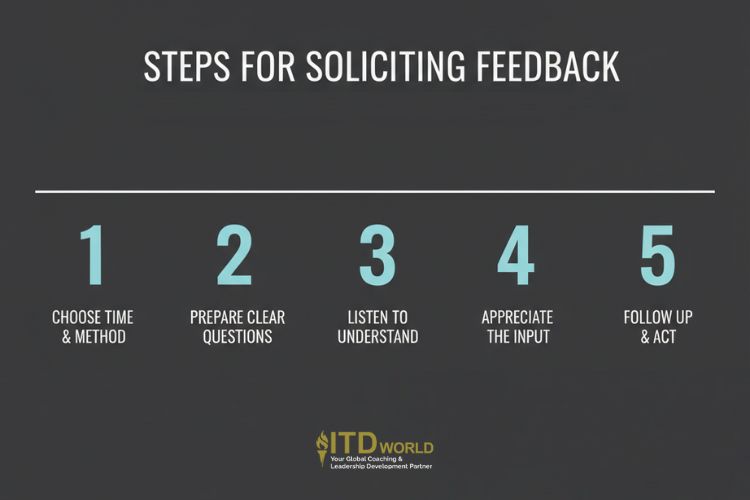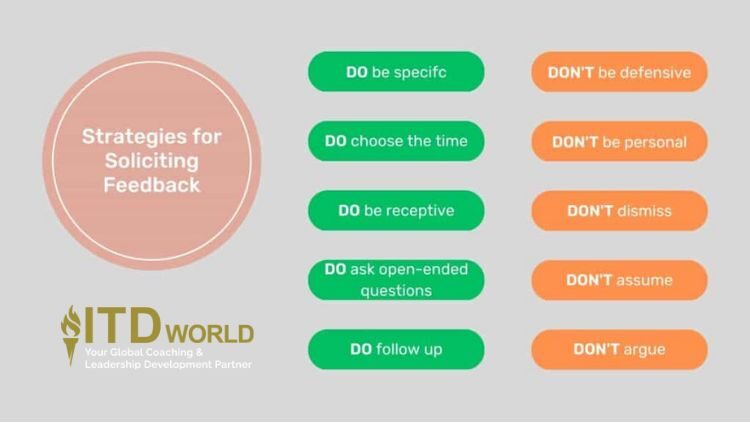Learn how soliciting feedback from others may lead to a more positive workplace, plus effective ways to receive and act on feedback.
A thriving workplace hinges on open communication and a culture of continuous improvement. While often overlooked, soliciting feedback is a crucial element in fostering a positive and productive environment. In this article, we will explore how to gather input from others and translate it into meaningful action.
|
Author: Jonathan M. Pham |
Highlights
- Soliciting feedback is the act of actively seeking input from various sources to improve performance, communication, and productivity. In the workplace, it is essential for improving communication, collaboration, job satisfaction, decision-making, and problem-solving.
- To effectively solicit feedback from others, one needs to be strategic, specific in their requests, open to input, and follow up on the input received. Using positive, appreciative, clarifying, and confirming language, along with open and attentive nonverbal cues, is crucial in the process.
- Tips for effective feedback solicitation involve being specific, choosing the right time and setting, remaining open-minded, asking open-ended questions, following up with action, and avoiding defensiveness, personalization, dismissal, assumptions, and arguments.
What Does It Mean to Solicit Feedback?
Soliciting feedback is the process of actively seeking input from others, usually with the goal of improving performance, communication, and overall productivity. Such opinions may come from a variety of sources – such as colleagues, customers, clients, or stakeholders – and are given in a variety of forms, including verbal and written communication.
Why is Soliciting Feedback Important?
In the workplace, soliciting feedback is crucial for fostering a culture of open communication and continuous improvement. Through the input of others, employees gain a more holistic awareness of their individual strengths and weaknesses, learn to address bad work habits, and discover areas for growth and development. Aside from that, the practice also encourages a culture of mutual respect and support, improves relationships and trust among team members.
By building up an environment that values feedback, individuals and organizations may enjoy significant rewards in the long run. In fact, a Gallup study found out that employee engagement increased by 3% with higher levels of feedback – while another one conducted by Gartner revealed that a company was able to increase customer satisfaction by 20% and customer retention by 15% through collecting and acting on customer feedback.

Why should we ask for feedback
Benefits of Soliciting Feedback in the Workplace
- Improved communication and collaboration
Creating an environment in which people are encouraged to give and receive feedback fosters transparent and sincere communication. The result is enhanced collaboration between team members and different departments within the organization. Through exchanging concepts, insights, and recommendations, employees learn how to work in harmony to recognize and solve challenges, brainstorm new innovative ideas, and accomplish shared objectives.
- Increased engagement and job satisfaction
Encouraging feedback is an essential component in developing a culture built upon trust and transparency, leading to amplified engagement and job fulfillment. By establishing an environment where employees feel heard, the door opens to opportunities for constructive conversations, idea sharing, and collaboration.
When individuals believe that their input is essential to the decision-making process, they are more likely to stay confident and invested in the prosperity of the company. This results in an empowered and driven workforce, leading to higher job satisfaction, talent retention, and organizational success. In fact, research has shown that organizations that value feedback achieve a 14.9% higher employee retention rate than those that don’t.
- Better decision-making and problem-solving
Soliciting feedback from a diverse group of stakeholders is a critical strategy for achieving long-term sustainable growth. When an organization seeks input from various individuals and teams, it opens the door to a wide range of perspectives, providing valuable insights that would have otherwise been overlooked. This approach leads to better-informed decision-making, ensuring the avoidance of potential blind spots, and promoting a more responsive, forward-thinking culture.
- Higher productivity and performance
By actively seeking feedback, leaders gain insights into potential inefficiencies, bottlenecks, and roadblocks that employees face daily. Such information may the be leveraged to optimize processes and workflows, resulting in increased efficiency and productivity.
Below is an example:
“The CEO of a manufacturing company regularly holds town hall meetings with employees to solicit feedback on how to improve the production process. During one of these sessions, a member from the assembly line raises his concern about a bottleneck that’s slowing down production. The CEO takes note of this comment and assigns a team of engineers to investigate the issue further. Later, the team identifies the problem as a faulty piece of equipment that’s been causing delays in the production line.
Thanks to the employee’s input, the company was able to identify and fix the issue, resulting in a 15% increase in production efficiency. The CEO praises the employee for speaking up and encourages others to do the same, emphasizing the importance of actively seeking feedback to improve the company’s processes and workflows.”
Read more: Leadership Feedback – The Key to Changing for the Better
Steps for Soliciting Feedback
Soliciting feedback effectively is a process that requires thought and preparation. Simply asking “How am I doing?” is unlikely to yield the specific, actionable insights needed for growth.
Here are five key steps to guide you through the process.
-
Set the stage by choosing the right time and method
The context in which you ask for input is just as important as the questions you use. To ensure the person feels respected and is capable of giving their undivided attention, you must be intentional about the timing and the medium.
- Timing: Try not to ambush someone when they are stressed, rushing to a deadline, or in a public setting. Instead, schedule a specific time. For a manager, this might be a dedicated 15-minute chat on their calendar. For a colleague, it could be asking, “Do you have a few minutes to talk about the X project when you’re free this afternoon?”
- Method: The best method depends on the situation.
- Face-to-face: Ideal for nuanced, in-depth conversations where you can read body language and ask follow-up questions in real-time. This is best for feedback from managers or close collaborators.
- Email or messaging: Useful for project-related feedback when a full conversation isn’t necessary, or when dealing with remote colleagues. It gives the person time to formulate their thoughts carefully.
- Anonymous surveys: Best for leaders gathering input from their team. Anonymity encourages more candid responses on sensitive topics like team culture, workflow, or management style.
-
Prepare clear and focused questions
Vague questions lead to vague answers. As such, try to come up with open-ended prompts focused on behavior and impact, not personality. For instance, instead of “Do you have any feedback for me?” or “What do you think of my work?” (which are too broad and put the pressure entirely on the other person), try something like:
- “During the client presentation this morning, what was one moment that you felt was particularly effective, and was there a point where my message could have been clearer?”
- “When we collaborate on projects, how can I better support your workflow to help us meet our deadlines more smoothly?”
- “I’m working on improving my leadership skills. In our last team meeting, how could I have done a better job of facilitating the discussion to include everyone’s voice?”
-
Listen to understand, not to reply
Once a question has been raised, your primary role is to listen – i.e. to absorb the information with an open mind and resist the natural urge to defend yourself or immediately explain your actions.
- Practice active listening: Pay full attention, maintain eye contact, and nod to show you’re engaged.
- Take notes: Writing down key points shows you are taking the input seriously and helps you remember the specifics later.
- Ask for clarification: If something is unclear, ask for more information. You can say, “Thank you for that. Could you give me a specific example of when you observed that? It would allow me to understand better.” Paraphrasing is also worth considering: “So, what I’m hearing is that I should provide more context at the beginning of my project updates. Is that correct?”
-
Appreciate & acknowledge the input
Giving honest feedback is difficult and requires a degree of vulnerability. It is a gift. Regardless of whether what the person says is positive or critical, it’s essential to thank them sincerely for their time and honesty. (e.g. “Thank you for taking the time to share this with me. I really appreciate your perspective, and this gives me a lot to think about”)
Such a positive reinforcement not only validates their effort but also makes them more willing to discuss further in the future, creating a sustainable cycle of open communication.
-
Follow up & take action
Feedback is useless if it doesn’t translate to reflection and, ultimately, action. After the conversation, take time to process the information; specifically, to identify one or two key takeaways that you can realistically work on.
- Create an action plan: This could be enrolling in a course, consciously changing a communication habit, or adopting a new process in your work.
- Close the loop: The most crucial, yet often forgotten, step. After some time has passed, follow up with the person who gave you the feedback and let them know what you’ve done with their advice. For example: “Hi [Name], I wanted to thank you again for your feedback on my presentation skills a few weeks ago. I’ve been making a conscious effort to start with a clear agenda, and I think it’s helping. I appreciate you pointing that out.”

How to Ask for Feedback in the Workplace
Feedback is an integral part of professional growth, but asking for it often proves to be challenging. Whether you are seeking input from a manager, a peer, or a subordinate, it is essential to approach the situation with tact and openness.
To help you navigate the process, here are some practical tips for soliciting feedback in different workplace scenarios:
From managers
When seeking feedback from your superior, it’s important to be strategic and intentional about the timing and approach. Scheduling a meeting in advance will give both parties ample time to prepare – and ensure that the conversation is productive.
During the meeting, it’s essential to clearly express your desire for honest evaluation, so that your manager understands the purpose of the conversation. Rather than dwelling on past mistakes, it’s more constructive to focus on actionable steps you can take to improve your performance in the future – so that both sides may move forward and work collaboratively towards achieving your goals.
Asking specific questions about your goals, skills, behaviors, or projects will provide your superior with a clear understanding of what you are looking to improve. For example, you could request for feedback on a recent project you completed, such as:
- “What could I have done differently to improve the outcome of this project?” or
- “How can I better align my work with the company’s overall objectives?”
Remember to approach the conversation with an open mind, even if the input is critical. Listening carefully without judging or becoming defensive is key to a productive and constructive dialogue. Finally, thank your manager for their time and input, and make sure to follow up on any actions or next steps discussed during the conversation.
Sample questions to ask:
- How do you think I did on this project?
- What are some areas that I can improve on?
- What are some skills that I should develop or strengthen?
- How can I better align my work with our team and organizational goals?
- How do you rate my performance in this area on a scale of 1-10?
- etc.
From colleagues
Before initiating a feedback conversation with your colleagues, be very specific of what you hope to achieve. For instance, if you are looking to improve your communication skills, ask them to give input on how well you convey your ideas during team meetings or presentations.
Additionally, make sure that you’re reaching out to them at the appropriate moment. For example, you wouldn’t want to ask your colleague for help when they’re in the middle of a high-pressure project or dealing with a tight deadline. Instead, choose a time when they’re likely to be receptive to your request, such as during a break or after work hours.
Sample questions to ask:
- How do you think we work together as a team?
- What do you appreciate about my work style or approach?
- Do you have any suggestions on how I can communicate or collaborate more effectively with you?
- Is there anything that I do that annoys or frustrates you?
- How can I support you better in your work?
From employees
As a leader or manager, it’s crucial to make your employees feel comfortable sharing their views. For instance, you could start a team meeting by asking for feedback on a recent project or initiative. Or, you could schedule one-on-one meetings with team members to discuss their experiences, concerns, and suggestions for improvement.
Alternatively, consider using an anonymous survey/ online tool to gather comments about issues that you would like to look into (e.g: company’s communication practices, employee recognition, or work-life balance). This approach may help participants feel comfortable sharing their opinions – which then opens the door for more candid responses.
Regardless of the method you choose, always make sure to follow up with actions and communication. If employees see that their suggestions are being taken seriously – and that changes are being made as a result, they will be more likely to feel valued and engaged in their work.

How to request feedback from coworkers
Most Effective Language to Use When Soliciting Feedback
The language you use when soliciting feedback can make a big difference in how the feedback is received and given. Here are some tips on how to make the most out of the process:
Tip 1: Use positive and appreciative language that shows your interest and gratitude for the other person’s ideas. For example, you could say:
- Thank you for your input. I really appreciate it.
- I’m glad you shared your perspective with me. It’s very helpful.
- I value your opinion and expertise. Thank you for taking the time with me.
- I’m always looking for ways to improve. Thank you for your honest and constructive advice.
Tip 2: Use clarifying and confirming language that shows your understanding and acceptance. For example:
- Can you give me an example of what you mean by that?
- Could you please explain how I can implement that suggestion?
- Do I understand correctly that you are saying…?
- So, what I’m hearing is that you think I should… Is that right?
Tip 3: Use nonverbal cues that demonstrate openness and attentiveness. These include:
- Maintaining eye contact and nodding your head.
- Smiling and using vocalizations like “mhmm” or “yes”.
- Keeping your arms uncrossed and your chest open.
- Leaning forward slightly and mirroring the other person’s gestures.
- etc.
Principles & Strategies of Soliciting Feedback
Dos
-
Be specific about what you are looking for
When requesting feedback from others, be very clear about your intentions. Explain to them why you are reaching out – and what you hope to gain from the conversation. This allows the other party to understand the importance of their input – and encourage them to provide thoughtful and constructive feedback.
Example: “Hi, I was hoping to get your input on my recent presentation. I really value your opinion and I’m looking to improve my public speaking skills. Would you be willing to share your thoughts on what I did well – and where I could improve?”
-
Choose the right timing and setting
As mentioned, timing plays an indispensable role in the success of your feedback request. Choose a time where your partner feels comfortable – and is able to provide focused attention. If they are busy, ask them when they have a few minutes to chat.
Then, when you do meet, make sure to find a quiet and private location where you won’t be interrupted. By being considerate of your partner’s schedule and needs, you increase the chances that they’ll be receptive and willing to engage in a productive conversation.
-
Be open-minded and receptive to others’ opinions
When soliciting authentic feedback as a means of increasing self-knowledge, it’s important to approach the process with an open mind and a willingness to learn. Remember that feedback is a gift – no matter how difficult it is to hear, it is crucial to your own personal growth. Therefore, avoid becoming defensive or argumentative – and always show your appreciation for the other party’s ideas.
Example: “Thank you for taking the time with me. I appreciate your honesty and will take your comments into consideration as I work to improve.”
-
Ask open-ended questions
A principle of soliciting feedback is to ask open-ended questions that allow the other person to express their thoughts and opinions freely – without feeling pressured or constrained. Refrain from leading questions that suggest a specific answer.
For example, if you say something like “Didn’t you think my presentation was great?”, you’re implying that the person should agree with you, which may not be the case. Instead, ask them:
- “What did you think of my presentation?” or
- “Do you have any suggestions for how I could improve?”
-
Follow up with action
Once the feedback session is about to come to an end, take the time to reflect on it and identify specific steps you may take to move forward. Then, follow through on those steps and communicate your progress to the other party.
Example: “Based on your advice, I’ve decided to enroll in a public speaking course to work on my presentation skills. Thank you for your help in identifying this area for improvement.”
Read more: Leadership Self-reflection – Leading with Clarity
Donts
-
Don’t be defensive
When receiving feedback, avoid getting defensive or arguing about what you think is right/ is not right. Remember that the other person is trying to help you improve, and that their opinion is just that – an opinion.
For instance, let’s say you just completed a project and your boss says that you could have done a better job. Instead of babbling about how hard you worked on the project, try to listen to what your boss is saying and consider how you can improve for next time.
You can respond by saying something like, “Thank you for your feedback. I appreciate your thoughts and will definitely take them into consideration for future projects.” This shows that you value the input and are willing to learn and grow from it.
Read more: Emotional Intelligence (EQ) – How to Harness Its Power
-
Don’t take it personally
Soliciting feedback is challenging – as it requires us to confront our own flaws and weaknesses. However, don’t forget that it is an essential part of personal and professional growth, and avoiding it can hinder our progress. Hence, perceive others’ input as an opportunity for growth – rather than an insult on your own personal worth.
Studies have shown that individuals who are open to feedback are more likely to be successful in their careers. For instance, a study published in the Harvard Business Review found that executives who were more receptive to feedback were rated higher in leadership effectiveness than those who were less open.
-
Don’t dismiss feedback out of hand
When someone provides their suggestions, make sure to keep an open mind and consider it thoughtfully. It can be tempting to dismiss other’s opinions – especially if they do not align with our own beliefs or perceptions, but doing so often hinders improvement.
Let’s say you just finished a project. Your supervisor mentioned that they felt your were struggling with communication. Your initial reaction may be to feel defensive and think that you did it just fine. However, if you spend time considering the criticism thoughtfully, you may realize that there were areas where you could have been more clear or concise.
Read more: Thoughtful Leadership – Why It Matters in Today’s Hectic World
-
Don’t make assumptions
Another principle when it comes to soliciting feedback is to be receptive to varying viewpoints. Avoid making assumptions about what the other person might say – and be prepared to receive input that may differ from your expectations.
To illustrate, let’s say you ask a colleague for input on a presentation you gave – and expect them to only comment on the content. However, if they only give recommendations about your delivery style, resist the urge to dismiss it – simply because it was not what you were anticipating. Instead, take a moment to consider their advice – and how you may improve for future presentations.
-
Don’t argue
Arguing can make the other person feel defensive or frustrated – worse, it may even discourage them from providing feedback in the future. Even if you disagree with what they’ve got to say, always listen respectfully and consider their perspective.
If you have questions or concerns, you can ask for clarification or additional information, but avoid getting into a heated argument. Remember, the goal of soliciting feedback is to learn and grow, not to prove someone wrong or defend your own position.

Strategies of soliciting feedback
Sample Email Asking for Feedback
Subject: Request for feedback on recent project
Dear [Name],
I hope this email finds you well. I wanted to reach out to you regarding the recent project we worked on together. I would greatly appreciate any feedback or thoughts you may have regarding my performance throughout the project.
Specifically, I would love to hear your thoughts on my communication style, the quality of my work, and how well I collaborated with the team. I am always looking for ways to improve my skills and contribute more effectively to the team’s success, and I believe your feedback could be immensely valuable in this regard.
If you have a few minutes to chat or would prefer to provide your feedback via email, please let me know. I’m flexible and happy to work with your schedule.
Thank you for your time and consideration, and I look forward to hearing from you soon.
Best regards,
[Your Name]
Examples of Soliciting Feedback in the Workplace
Let’s dive into two real-life examples that demonstrate the power of asking for feedback.
(Source: Harvard Business Review)
Case study 1: Michelle
Michelle Morgan is an ambitious online marketing professional who wanted to grow her skills and career. Michelle learned that to get more meaningful feedback from her boss, she needed to be specific and ask for actionable advice – rather than vague and general comments.
By asking questions like, “How did I do on this presentation?” and “What are some things I can do better next time?”, Michelle was able to receive more useful and constructive input from her boss. This not only improved her performance and confidence – but also strengthened her relationship with her superior.
Case study 2: Deloitte
Deloitte, a global consulting firm, recognized its traditional annual review and rating system was ineffective in providing feedback and motivation to its employees. To address this, Deloitte reinvented its performance management system by introducing a new tool called “performance snapshot.” This tool allowed managers to provide feedback to their employees at the end of every project or quarter using four questions that focused on the employee’s performance.
By collecting feedback more frequently and informally, Deloitte created a more agile and responsive performance management system, reducing the time spent on performance reviews by 90%.
Read more: Continuous Feedback – A Cornerstone of Modern Workplace

Final Thoughts
Soliciting feedback is a crucial component in building a better workplace – it helps to foster a culture of trust and openness, leading to improved communication, increased engagement, and better business outcomes. By following the guidelines above, you can contribute to building up an environment where feedback is valued and leveraged as a tool for growth and improvement.
Other resources you might be interested in:
- Mistakes Leaders Make When Giving Feedback – and Better Ways to Communicate
- 63 Feedback Quotes: Turning Input Into Positive Growth
- 8 Effective Coaching Skills for Leaders & Managers
- Mentoring: Guide to Establishing a Win-Win Relationship
- Visibility at Work: Key to Sustainable Career Advancement

